List of rolling stock preserved on the West Somerset Railway
| West Somerset Railway | |
|---|---|
 | |
| Locale | Minehead, Somerset, England |
| Terminus |
Minehead Bishops Lydeard |
| Commercial operations | |
| Built by |
West Somerset Railway Minehead Railway |
| Original gauge |
7 ft (2,134 mm) to 1882 4 ft 8 1⁄2 in (1,435 mm) since |
| Preserved operations | |
| Operated by | West Somerset Railway |
| Stations | 12 |
| Length | 22.75 miles (36.61 km) |
| Preserved gauge | 4 ft 8 1⁄2 in (1,435 mm) |
| 1862 | Opened to Watchet |
| 1874 | Line completed |
| 1882 | Converted to standard gauge |
| 1971 | Closed |
| Preservation history | |
| 1975 | Light Railway Order Granted |
| 1976 | Line (between Minehead and Williton) re-opened |
| 1978 | Stogumber re-opens |
| 1979 | Bishop's Lydeard & Crowcombe Heathfield both re-open |
| 1981 | Line marked 10th anniversary of closure |
| 1987 | Doniford Beach Halt opens |
| 2009 | Norton Fitzwarren re-opens |
| Headquarters | Minehead |
The rolling stock preserved on the West Somerset Railway is used to operate trains on the West Somerset Railway (WSR), a heritage railway in Somerset, England. There is a variety of preserved steam and diesel locomotives and diesel multiple units, passenger coaches and goods wagons. Most of these are typical of Great Western Railway (GWR) branch lines in Somerset, or of the Somerset and Dorset Joint Railway (SDJR). Some are owned by the railway itself but most are owned by various individuals or voluntary groups such as the West Somerset Railway Association (WSRA), Diesel and Electric Preservation Group (DEPG), and Somerset and Dorset Railway Trust (SDRT). The line is also regularly visited by locomotives based elsewhere. Some come for a day on a railtour, others for a few days or weeks to take part in a special gala, but a few stay for many months and form part of the stock working scheduled trains. Over the years these have included well known locomotives such as City of Truro, Taw Valley, Duke of Gloucester, Evening Star,[1] Royal Scot, Tornado,[2] Bittern, Britannia, Sir Lamiel and King Edward I.[3]
Maintenance facilities
The old goods shed at Minehead has been converted to an engine shed for inspections and running repairs to the operational locomotives. A secure compound at Bishops Lydeard is the base for locomotives working from that end of the line. Most diesel locomotives work from the DEPG depot at Williton. The permanent way department is based at Dunster and maintain their wagons in the old goods shed there.[4]
Restoration and heavy repairs are undertaken at several locations, including workshops attached to the engine sheds at Minehead and Williton. There is also another shed at Williton used for steam locomotive restoration and vintage coaches, the operating coaches are maintained in a modern shed at Minehead, and the SDRT have workshops at their museum at Washford.[4]
Main line steam locomotives
The first main line locomotive to operate on the line when it reopened in 1976 was 6400 Class 6412 which was purchased from the Dart Valley Railway and sold back to the South Devon Railway Trust in 2008. During its time on the West Somerset Railway it carried Flockton Flyer nameplates for a while after appearing in the television series of that name.[5][6]
Other locomotives that have been on the railway but now gone elsewhere include GWR 2251 Class 3205 which is now on the South Devon Railway,[7] BR Standard Class 4 2-6-4T 80136,[8] and LB&SCR 'Terrier' 32678 Knowle. This had been displayed at the Butlins holiday camp at Minehead from 1964 until 1975; restoration was started at Minehead but was completed by the Kent and East Sussex Railway.[9]
The following locomotives are currently based on the West Somerset Railway but may sometimes be away from the line. They are all Great Western Railway designs unless otherwise stated.
Operational
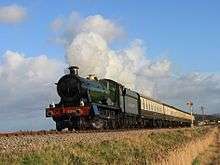
- 6960 Raveningham Hall – 6959 Class modified 'Hall' 4-6-0
- 6960 is a later version of the original 4900's but with a number of changes: the class had Plate frames, cylinders cast separately from the smokebox saddle, larger super heaters & flatsided Hawksworth tenders.
- 6960 was withdrawn from service in June 1964 and sold to Woodham Brothers scrapyard in Barry, South Wales for cutting up. She was saved in 1972 and moved to Steamtown Carnforth as the 26th departure from Barry. Restored in 1975, she was then based at the Severn Valley Railway where she ran with 4930 Hagley Hall's Hawksworth tender while her own was put behind 4930. She left the Severn Valley in 1996 and was eventually sold to Jeremy Hosking. After completion of an overhaul in 2009 she moved to the West Somerset Railway.

- 7828 Odney Manor – 7800 Class 'Manor' 4-6-0
- The 'Manor' Class was designed by Charles Collett as a large lightweight locomotive for long but lightly constructed routes, mainly in west Wales and south west England. Construction of the first 20 started at Swindon in 1938, followed by another 10 in 1950 for British Railways.
- 7828 Odney Manor was first sent to Shrewsbury shed and spent nine years there. 1961 saw it move to Croes Newydd, then two years later it found its way to Aberystwyth for a short while before returning to Shrewsbury, from where it was withdrawn in 1965, moving to Barry in 1966. It was rescued privately in 1981 and moved to the Gloucestershire Warwickshire Railway where restoration was completed by 1987. It worked on the Gwilli Railway, Llangollen Railway and East Lancashire Railway before coming to the WSR in 1995. Its owners sold it to the WSR in 2004[10] On 17 June 2011 it was renamed Norton Manor after 40 Commando’s base alongside the railway at Norton Fitzwarren. The Great Western Railway had intended to give this name 7830 but the order for this locomotive was cancelled. It has been repainted in the BR lined green livery that it carried in 1957.[11]
- 44422 – LMS Class 4F 0-6-0
- The first of these Class 4Fs were built for the Midland Railway to a design by Henry Fowler in 1911. They continued to be built after the 'grouping' of 1923 by the London, Midland and Scottish Railway until 1941 by which time 772 had been built. Number 4422 was built at Derby Works in 1927. It was initially allocated to Leicester, then to Wigston in 1929, Bristol in 1940, and Bath Green Park in 1948, when it was renumbered 44422. It spent the rest of its working life in the South West of England, often running over the former Somerset and Dorset Joint Railway. It was withdrawn from Gloucester shed in 1965 and sold to the Woodham Brothers for scrap. It was purchased by the 44422 Locomotive Company in 1977 and taken to the Churnet Valley Railway, where it was eventually restored to working order in 1990.[12] Since then it has worked on many preserved lines, including the East Lancashire and Nene Valley railways. The locomotive arrived at the West Somerset Railway on a 25 year loan agreement following overhaul at Crewe Heritage Centre in February 2016.[13][14]
- 53808 – Somerset and Dorset Joint Railway 7F 2-8-0
- 53809 – Somerset and Dorset Joint Railway 7F 2-8-0
- The S&DJR had a number of these large locomotives based at Bath Green Park for working heavy freight trains over the Mendip Hills, but they also took their turn on summer Saturday passenger trains. Their number 88 was built by Robert Stephenson and Hawthorns in 1925. After it had been taken into the London Midland and Scottish Railway fleet it became number 9678, but this was later changed to 13808 so its British Railways number was 53808. It then received a second hand boiler from Midland Railway 4P 4-4-0 41092. It was sold and moved to Woodham Brothers’ Barry scrap yard in 1964, but was rescued by the SDJT in 1970. Their museum at Radstock was closed in 1976 and so their locomotives were moved to the WSR. It finally returned to steam in 1987[15] and has carried several numbers and liveries since then; it is currently (from March 2016) in British Railways black with number 53808. Returned to service in 2016 following a ten-yearly overhaul.
- Sister locomotive 53809 arrived on temporary loan to the line in 2016.
Out of service
- 4110 – 5101 Class 'large prairie' 2-6-2T
- The same class of locomotive as 4160, 4110 was built in 1936 and spent most of its life working suburban trains in the West Midlands. It was also based at Taunton shed twice in the 1960s and was withdrawn from service in 1965. It was purchased by the Great Western Railway Preservation Group based at the Southall Railway Centre in 1979. West Somerset Railway purchased 4110 in 2015 and it is now at Minehead awaiting restoration.
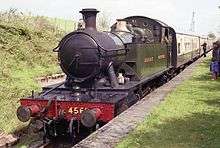
- 4561 – 4500 Class 'small prairie' 2-6-2T
- The 'small prairie' locomotives were designed for lighter duties on often lengthy branch lines. The 4500 Class were introduced in 1906. 4561 was built in 1924, working initially in the Birmingham area for three years before moving southwards, settling in Truro from 1938. Twenty years later it moved to Newton Abbot from where it regularly worked the Kingsbridge branch line. In 1962 it was sold for scrap to the Woodham Brothers. It was purchased by the WSRA in 1975 and was placed in service in 1989. It was taken out of service in 1998 when its boiler certificate expired[16] and is now undergoing a full overhaul.[17]
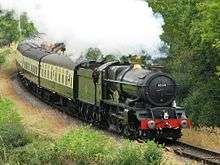
- 6024 King Edward I – 6000 Class 'King' 4-6-0
- The 'Kings' were introduced in 1927 and were the Great Western Railway’s largest express passenger locomotives. King Edward I, which was built in 1930, is one of the heritage steam locomotives that is equipped to Network Rail’s standards for working trains on the main line and is regular seen at the head of excursions and trains such as the Torbay Express. 6024 has spent several periods based on the railway between working main line services. It returned to the railway on 17 March 2012 and worked a number of trains in the following weeks and was then moved into Minehead workshops for its ten-yearly overhaul.[18]
- 6024 is currently undergoing her 10 yearly overhaul and it's hoped for 6024 to be back in operation at some time in 2017. With gauging issues being a problem for the King class, 6024 is having new cylinders fitted which will be cast in a higher strength material allowing the width of 6024 to be slightly reduced. This will help overcome the majority of gauging issues that became apparent during her last operating period on the mainline.[19]

- 9351 – 9351 'mogul' 2-6-0
- Great Western locomotives were built from a range of standardised components, which were assembled in different ways to suit different traffic needs. The basic parts of the 'large prairie' 2-6-2Ts were considered at different times as being the possible basis of a small 2-6-0 'mogul', but this was never followed through. 5101 Class number 5193 was purchased by the WSR in 1998 when its owners were unable to complete its restoration after its rescue from Barry in 1979. Because of the degree of work needed to restore it as a tank locomotive, and because a small tender locomotive was thought more useful on the lengthy railway, it was decided in 2000 to convert it to this mooted 2-6-0. Work was completed in 2004 when it appeared in plain GWR green livery.[20]

- 7821 Ditcheat Manor – 7800 Class 'Manor' 4-6-0
- The 'Manor' Class was designed by Charles Collett as a large lightweight locomotive for long but lightly constructed routes, mainly in west Wales and south west England. Construction of the first 20 started at Swindon in 1938, followed by another 10 in 1950 for British Railways. 7821 Ditcheat Manor is now the property of the WSRA.[21] It was moved in 2010 to Swindon's Steam Museum where it was displayed for five years, returning in November 2015, and now requires an overhaul before returning to service.[22][23] It is painted in BR black livery.
Off-site

- 4160 – 5101 Class 'large prairie' 2-6-2T
- The first 'large prairie' locomotives were built by the GWR in 1909, but 4160 was not built until 1948. By this time British Railways had taken over, and so it is preserved in BR green livery with the later "lion in wheel" totem. It was delivered to the engine shed at Barry and worked from various sheds around south Wales until it was withdrawn from Severn Tunnel Junction in 1965. 4160 then returned to Barry, but this time to Woodham Brothers’ scrap yard. It was purchased by the Birmingham Railway Museum in 1974 but restoration was not completed before it was sold again to the Plym Valley Railway. The engine remains wholly owned by 4160 Ltd since its purchase by Plym Valley Railway who originally formed the 4160 limited company. It was finally returned to service in 1993. The boiler ticket expired in January 2016 and it is currently at the Llangollen Railway for its 10-year overhaul.[24]
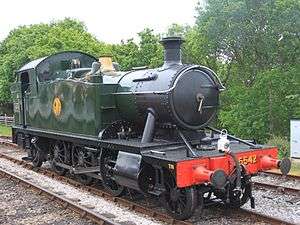
- 5542 – 4575 Class 'small prairie' 2-6-2T
- The 4575 class, similar to the 4500 Class represented by here 4561, but with a larger water tank and other improvements, first appeared in 1927. Number 5542 was turned out from Swindon in 1928 and was immediately sent to Gloucester but it then moved southwards and even spent a time based at Taunton. Withdrawn in 1961, the following year it too was sold to the Woodham Brothers and spent 13 years at Barry before being brought by the WSRA. Restoration took until 2002 and it is now in service in GWR unlined green livery. As it is a little underpowered for the heavy trains that now run on the railway it often spends long periods working on other railways.[25] Similar 5521 was purchased from Woodhams’ at the same time as 4561 and 5542 but was sold on to the Dean Forest Railway before it was restored.[26]
Main line diesels
The following mainline diesel locomotives are currently based on the railway:
_light_engine.jpg)
- The 'Western' class were the last and most powerful of the Western Region's diesel-hydraulics. 1010 was built at Swindon in 1962 and was initially based at Old Oak Common TMD in London. After just 14 months it moved to Laira which was to be its most familiar depot, but it did spend a short time working out of Landore TMD in Wales during 1968. 1010 was bought by Foster Yeoman after being withdrawn by British Rail in 1977 and was moved to their depot at Merehead. The locomotive moved to Didcot Railway Centre in 1985 where it was restored to working order. A further move saw it brought to the WSR in 1991 and it was then sold to the DEPG who had been responsible for its restoration and operation. During its time with Foster Yeoman it assumed the identity of 1035 Western Yeoman but it returned to its original number and name in 1992. It is currently painted in British Railways maroon livery.[27]

- The Class 47, or 'Brush Type 4', was the British Railways standard large diesel-electric locomotive of the mid-1960s and was designed to operate similar trains to the 'Westerns'. Only a few were initially allocated to the Western Region and most of these were given names that had originally been carried by Great Western Railway locomotives, in 1661’s case this dated back to the broad gauge Star Class but the North Star name had also been carried by four other GWR locomotives, the most recent being Castle Class 4000. 1661 received its name in a ceremony performed by Ray Gunter, the Minister of Labour, at London Paddington station on 20 March 1965.[28] It was allocated to Landore TMD until 1973 when it was transferred to Old Oak Common, after which it moved around various sheds. Its number was changed to 47077 under the TOPS scheme in 1974 and then became 47613 when fitted with electric train heating equipment ten years later.[29] In 1989 it was rebuilt with additional fuel tanks which caused it to be renumbered again as 47840. It was part of the Virgin Trains fleet until 2002 and then was hired to various operators by its owner, Porterbrook. It was finally withdrawn in 2008,[30] repainted into two-tone British Railways green livery, renumbered back to 1661, and sent to the WSR. It is now part of the DEPG fleet based at Williton.[31]

- The Class 33 was built by the Birmingham Railway Carriage and Wagon Company and were the Southern Region’s principal diesel-electric locomotive. They were also familiar working inter-regional freight and passenger trains on the Western Region. 6566 was renumbered 33048 and 6575 became 33057 in 1973. The former spent most of its working life at Hither Green TMD from where it was withdrawn in 1995 but was retained for staff training until sold to a private buyer for preservation in 1997 when it moved to the WSR. It carries British Rail green livery with full yellow ends. 6575 was also based at Hither Green until 1985 after when it spent time at both Stewarts Lane TMD and Eastleigh TMD; from 1991 it carried the name Seagull. It was withdrawn in 1997 and eventually sold to freight operator Direct Rail Services, however it was never put into traffic and instead was sold to a private buyer and moved to the WSR in 2005. It was intended to be a source of spares for 6566,[32] however its restoration was started in February 2010.[33] It also carries green livery but with the original half-height yellow ends.[34]
- The 'Hymek' class of mid-power diesel-hydraulics were built by Beyer Peacock for working both passenger and freight services on the Western Region and were familiar on the Minehead branch before it became a heritage railway. Both of the WSR’s were delivered to Bristol Bath Road TMD in January 1962. Both moved to Old Oak Common in 1971 and were withdrawn in 1975, although 7018 spent a couple of months at Cardiff Canton TMD in 1966. 7017 was purchased by the DEPG and moved to Taunton in 1975; 7018 was sold for private preservation and moved to Didcot where the DEPG would restore it, and rejoined 7017 on the WSR in 1990.[35] 7017 is in traffic carrying green livery; 7018 is currently being overhauled at Williton and is also in green livery.
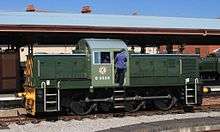
- 9518 – Class 14 0-6-0
- 9526 – Class 14 0-6-0
- The Class 14 were small diesel-hydraulic locomotives built at Swindon for working Western Region branch lines but they were soon surplus to requirements as these were closed following the Reshaping of British Railways report. 9518 entered service in October 1964 at Cardiff Canton and worked from there until placed in store April 1969. It was sold to the National Coal Board for use at Ashington Colliery in Northumberland.[36] After it was no longer needed by the NCB, it went to the Nene Valley Railway to provide spare parts for other Class 14s that were based there. Late in 2011 it was moved to Williton and there are long-term plans to restore it to service.[37]
- 9526 was delivered to Bristol Bath Road in January 1965, joined 9518 at Cardiff Canton in May 1967 but was withdrawn before the end of 1968. It was then purchased by Blue Circle Industries to shunt the sidings at their cement factory at Westbury alongside the Taunton to London line. It was sold to the DEPG in 1979 and arrived on the WSR on 3 April 1980. Restoration was completed in 1984; it carries British Railways green livery and is used on freight or light passenger trains.[36][38] Another Class 14, D9551, also worked on the West Somerset Railway for many years but has now moved elsewhere.[39]
Shunting locomotives
Industrial steam
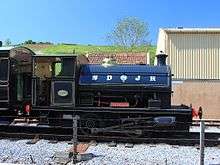
Many of the trains operated in the early years of the West Somerset Railway were hauled by one of two identical Bagnall 0-6-0ST locomotives that had been designed for the Steel Company of Wales’ Margam Steelworks in 1951. They were Vulcan (works number 2994) and Victor (2996). Both have since left the railway. Other industrial locomotives that have also moved elsewhere were Hudswell Clarke 0-6-0T Jennifer (1731, built 1942), Hawthorn Leslie 0-6-0ST Isabel (3437 of 1919), fireless Bagnall 0-4-0 No. 1 (2473 of 1932),[40] Peckett 0-4-0 Whitehead (1163 of 1908?),[41] and former Port of Bristol Portbury (Avonside 1764 of 1917) and Henbury (Peckett 1940 of 1937) which are now on the Bristol Harbour Railway.[42]
There are currently just two industrial steam locomotives based on the railway:
- Peckett works number 1788 was an R3 Class built in 1929 for the Writhlington Collieries Company which spent its working life shunting around collieries in the Radstock area of Somerset. It was delivered to Writhlington’s Kilmersdon colliery, being transferred with the colliery to the National Coal Board in 1947. It continued to work at Kilmersdon but spent some time at the nearby Norton Hill colliery in 1950-53 and again in 1958-59. Kilmersdon closed in 1973 and the following year the locomotive was moved to the nearby Somerset and Dorset Railway Museum.[43] The museum closed in 1975 and the SDRT moved their Peckett to the WSR in May 1975. It has now acquired a Kilmersdon name (which was never carried while at the colliery) and is steamed from time to time for shunting around the SDRT museum at Washford. It carried a green livery for many years[44] but in 2013 was repainted in the Prussian blue livery of the Somerset and Dorset Joint Railway.[45]
Diesel shunters
Shunting locomotives that have been based on the railway but now moved elsewhere are British Rail Class 04 2205,[46] Class 07 2994,[47] Class 08 3462 which went to the Watercress Line in 2013,[48] Ruston and Hornsby 0-4-0 183062 which used to shunt the milk depot at Chard Junction, and former Stanton and Staveley Iron Works 57, a Rolls Royce Sentinel 0-6-0.[49]
The following are currently based on the railway:


- 2133 – British Rail Class 03 0-6-0
- 2271 – British Rail Class 04 0-6-0
- British Railway's class 03 and 04 shunters were small 0-6-0 locomotives powered by 204hp Gardner engines. The former were built at the railway's own workshops such as Swindon, while the latter were ordered from the Drewry Car Co., although most of the work was done by outside companies.
- Built at Swindon in 1960, 2133 spent many years based at Taunton and working in various goods yards in the area. After just nine years working with BR it was sold to British Cellophane for shunting their factory sidings at Bridgwater.[50] It was no longer needed in 1994 and so was donated to the WSR by Courtaulds, the then owner of the site. It carries BR green livery and can usually be found working as the station pilot at Minehead. A second locomotive, number 03119, was based on the railway from 1996 until 2011.[51]
- 2271 was built by Robert Stephenson and Hawthorns in 1958 and delivered to Tyne Dock shed. It found its way to Bradford in 1968 but was withdrawn the following year. It then went to Rotherham where it shunted CF Booth’s scrap yard for a while before being sold to nearby engineers Thomas Hill in 1972. In 1975 it moved to the Midland Railway Centre to be preserved but transferred to the WSR in 1982. It is carrying a fictitious blue livery with 'Gardner' logos.[52][53]
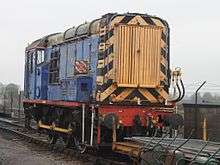
- D4107 – Class 09 0-6-0
- A larger diesel shunter, this one was built by British Railways at Horwich Works in 1961. At first numbered D4107 and sent to Carlisle, in October 1968 it was transferred to the Southern Region, initially at Hither Green TMD where it would have worked alongside its predecessor here (Class 08 D3462). It was renumbered to 09019 in 1973.[54] When British Rail was split up in readiness for privatisation it was allocated to the Mainline Freight business and repainted in their blue colours,[55] which it still carried when it arrived at Bishops Lydeard in 2013 but it now wears British Rail green livery.
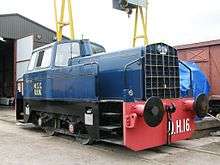
- DH16 – Rolls Royce Sentinel 0-4-0
- DH16 is a Sentinel-type shunter built by Rolls Royce at Shrewsbury for the Manchester Ship Canal (MSC) railway fleet in 1964, fitted with a diesel-hydraulic transmission but with a chain final drive. It was sold on to Bowater’s paper mill in Ellesmere Port in 1970.[56] In 1980 it entered preservation, initially on the East Lancashire Railway, but in 2001 it was moved to the WSR. Painted in MSC blue it is used as a shunter for the DEPG depot at Williton.[57]

- (1) – Andrew Barclay 0-4-0DH
- (2) – Andrew Barclay 0-4-0DH
- This pair of shunters with hydraulic transmissions were built in 1972 for the Royal Ordnance Factory at Puriton in Somerset. Surplus to requirements since 1991, they are on long term loan to the WSR and are based at Dunster for shunting the permanent way depot. They are both painted green but neither currently carries visible numbers.[58] They can be distinguished as number 1’s Barclay works plates have blue backgrounds, while number 2’s are red.
- (24) – Ruston and Hornsby 0-4-0DM
- This 88DS four-wheel shunter was built in 1941 for the Air Ministry but later worked at many varied industrial sidings. It arrived at the Bath Gas Works of the South West Gas Board in 1964 but gas production finished in 1971,[43] just three years after the shunter had been fitted with a new 80hp engine. It then found its way to the Somerset and Dorset Railway Museum at Radstock and moved, with the rest of their stock, to Washford where it is the regular shunter.[58][59]
- 200793 Gower Princess - Ruston and Hornsby 0-4-0DM
- A 48DS four-wheel shunter built in 1940 for William Evan's Old Mill Colliery at Radstock, Somerset.[60]
Diesel Multiple Units

The railway operates a DMU which is formed as a three or four-car set depending on traffic levels. It is a 'suburban' type with doors to each seating bay but formed form cars of two different classes. The Class 115 units were built by British Railways at Derby Carriage and Wagon Works and originally used on services out of London Marylebone station and in the Liverpool area. The Class 117 units look similar but were built by the Pressed Steel Company and used out of London Paddington station and on the Western Region, including on local trains around Taunton. The cars are either Driving Motor Brake Second (DMBS) or Trailer Composite (TC). All are fitted with gangway connections within the unit and some modifications have been made to allow for mobility-impaired passengers.
| Class | Type | Number | Comments |
|---|---|---|---|
| 115 | DMBS | 51859 | In service in British Railways green livery.[61] |
| 115 | DMBS | 51880 | In service in British Railways green livery.[61] |
| 115 | DMBS | 51887 | Undergoing extensive restoration at Minehead.[62] |
| 117 | TC | 59493 | In service in British Railways green livery.[61] |
| 117 | TC | 59506 | [63] |
| 115 | TC | 59678 | [63] In service in British Railways green livery, it has been modified with a small buffet counter and is the usual centre coach for the DMU when it is operating as a three-car set. |
In the early years a number of two-car sets were operated. Each was formed of a motor brake second (DMBS) and driving trailer composite (DTC), although sometimes they were formed into four-car trains. The first two sets were British Rail Class 103 built by Park Royal Vehicles (DMBSs 50413 and 50414, DTCs 56168 and 56169). These were later joined by two Gloucester-built Class 100s (50341 and 51118, 56097 and 56099) and a Cravens Class 105 (51482, 56121).[64] Two further Class 115 DMBSs have also been on the railway. The body of 51663 has been stripped off this but the chassis is in store at Dunster for future use.[61] 51852 was purchased by the WSRA as a spare driving car in 1994 but sold to the Dean Forest Railway for spares in 2011.[65]
 DMBS 51859
DMBS 51859 TC 59678 with buffet
TC 59678 with buffet TC 59493
TC 59493 DMBS 51880
DMBS 51880
Former Residents on the WSR
Steam
Note that the locations given may not be current as locomotives move between railways from time to time.
- GWR 2251 Class 0-6-0 no 3205. Operational at the South Devon Railway.
- GWR 2884 Class 2-8-0 no 3850. Undergoing overhaul at the Gloucestershire Warwickshire Railway.
- GWR 4200 Class 2-8-0T no 4277. Operational at the Dartmouth Steam Railway.
- GWR 4900 Class 4-6-0 no 4920 Dumbleton Hall. Stored at the South Devon Railway awaiting an overhaul.
- GWR 4900 Class 4-6-0 no 4936 Kinlet Hall. Undergoing Mainline standard overhaul at Tyseley Locomotive Works.
- GWR 6400 Class 0-6-0PT no 6412. Operational at the South Devon Railway.
- GWR 7800 Class 4-6-0 no 7820 Dinmore Manor. Operational at the Gloucestershire Warwickshire Railway.
- SR West Country class 4-6-2 no 34046 Braunton. Operational, Mainline certified. Based at LNWR Crewe.
- SR Battle of Britain class 4-6-2 no 34053 Sir Keith Park, bought originally as spares for sister engine 34046. Operational at the Severn Valley Railway. It visited the West Somerset Railway in 2016 for the S&D steam gala, the first time it had operated on the railway.
- BR Standard Class 4 2-6-4T no 80136. Operational at the North Yorkshire Moors Railway.
- LB&SCR A1 Class 0-6-0T no 78/32678 Knowle. Operational at the Kent and East Sussex Railway.
- Bagnal 0-6-0ST no 2994 Vulcan. Under overhaul at the North Tyneside Railway.
- Bagnal 0-6-0ST no 2996 Victor. Operational at the Lakeside and Haverthwaite Railway.
Diesel
- BR Class 04 0-6-0 no D2205, currently based at Peak Rail.
- BR Class 08 0-6-0 no D3462, currently based at Mid Hants Railway.
Coaches
Most trains are formed from British Rail Mark 1 coaches painted in a chocolate and cream livery based on the most familiar one used by the GWR but with WSR crests.[66][67]
| Code | Type | Numbers | Comments |
|---|---|---|---|
| TSO | Tourist Second Open | 4260, 4419, 4435, 4449, 4599, 4660, 4875, 4884, 4909, 4911, 4956, 5002, 5024, 5025, 5030 | All operational, 4419 being the most recent to enter service, doing so during 2015. |
| Converted partly for Wheelchair Access | 4876, 4884 | Converted by the WSR; TSO coaches with some seating bays removed to carry wheelchairs. Both operational. | |
| Converted to Buffets | 4346, 4814, 4987 | Converted by the WSR; TSO coaches with some bays removed for buffet space. All operational. | |
| SK | Second Corridor | 24985, 25308, 25323, 25454 | All operational bar 25454 which is stored at Minehead. |
| BSK | Brake Second Corridor | 35257 | Operational. |
| BSO | Brake Second Open | 9227, 9278, 9380 | 9278 and 9380 modified for wheelchair users. All three operational. |
| BG | Brake Gangway | 80736 | Converted by the WSR to carry up to 12 wheelchairs. It is also fitted with six seats and a toilet. Operational. |
The 'Quantock Belle' dining train is painted in a Pullman-based livery with each Mark 1 coach named in Pullman car style:[66]
| Code | Type | Number | Name |
|---|---|---|---|
| RMB | Miniature Buffet | 1804 | Aries |
| RUB | Restaurant Unclassified | 1909 | Orion |
| FO | First Open | 3108 | Meteor |
| BCK | Brake Composite Corridor | 21174 | Phoenix |
| BSK | Brake Second Corridor | 35408 | Jupiter |
Work is underway to restore a set of Great Western Railway coaches for use on the railway. Among those that are restored, or likely to be in the next few years are:[68][69][70]
| Style | Code | Type | Number(s) | Comments |
|---|---|---|---|---|
| Toplight | CK | Corridor Composite | 7740 | |
| Toplight | TK | Third Corridor | 2573, 3631, 3639, 3665, 3668 | 3668 is currently used as a camp coach for railway volunteers at Bishops Lydeard as is 2573 at Blue Anchor along with 3885 and 3980 which are not scheduled for restoration.[66] |
| Collett | TK | Third Corridor | 4546, 4553, 4786, 5848, 5856, 5929 | |
| Toplight | BCK | Brake Composite Corridor | 7538 | |
| Collett | BCK | Brake Composite Corridor | 6705 | Undergoing restoration at Williton[71] |
| Collett | BTK | Brake Third Corridor | 5102, 5131 | |
| Clerestory | Sleeper | 9038 | Restored, normally on display in the museum at Bishops Lydeard.[66] | |
| Collett | Auto coach | 169 | Undergoing restoration at Williton. 4575 Class locomotive 5542 is fitted with the control gear that will allow it to be driven from the auto coach once it is complete.[66] | |
| Hawksworth | GWR-design BR(W) Inspection Saloon | W80976W | Operational. Sometimes attached to Quantock Belle dining train and can be hired out privately. Was added to rear of some Autumn Steam Gala 2014 trains for public use. | |
- BRMark 1 TSO 4460
- BR Mark 1 TSO 5030
- BR Mark 1 BSO 21174 Phoenix
 Sleeping coach 9038
Sleeping coach 9038
Goods wagons
Freight wagons are classified as either 'operational' for use in engineering trains, 'heritage' which are suitable for use in a demonstration heritage freight train that is used on special occasions, or 'museum' if only allowed to run short distances.[72]
References
- ↑ Smith, Keith (2007). West Somerset Railway Stockbook (6 ed.). Taunton: West Somerset Railway Association.
- ↑ "Tornado on the West Somerset Railway Proves a huge Success". 2009 Archived News. West Somerset Railway. 2009. Retrieved 2009-10-14.
- ↑ "Spring Steam Gala March 2011". West Somerset Railway Journal. West Somerset Railway Association (134): 24–27. 2011.
- 1 2 Oakley, Mike (2006). Somerset Railway Stations. Bristol: Redcliffe Press. ISBN 1-904537-54-5.
- ↑ Smith, Keith (1987). West Somerset Railway Stock Book (3rd ed.). West Somerset Books. pp. 11–13. ISBN 0-9510426-4-5.
- ↑ "Pastures New for Pannier 6412". West Somerset Railway Journal. West Somerset Railway Association (124): 6. 2008.
- ↑ Smith 1987, p. 3
- ↑ Smith 2007, pp. 22–23
- ↑ Reed, Mike (1989). The Island Terriers. Southampton: Kingfisher Railway Productions. pp. 38–41. ISBN 0-946184-46-1.
- ↑ Smith 2007, pp. 15–16
- ↑ "Motive Power". West Somerset Railway Journal. West Somerset Railway Association (135): 43–46. 2011.
- ↑ "The 44422 Locomotive Company Limited". The 44422 Locomotive Company Limited.
- ↑ "Press Release LMS 4F 44422 TO MOVE TO THE WEST SOMERSET RAILWAY AFTER OVERHAUL IS COMPLETED". vticket.co.uk.
- ↑ "44422 Moves to the West Somerset Railway". The 44422 Locomotive Company Limited. Wordpress.com. 19 February 2016. Retrieved 20 February 2016.
- ↑ Smith 2007, pp. 18–20
- ↑ Smith 2007, pp. 7–8
- ↑ "Locomotion". West Somerset Railway Journal. West Somerset Railway Association (131): 50–57. 2010.
- ↑ "Steam Motive Power". West Somerset Railway Journal. West Somerset Railway Association (137): 51. Winter 2012.
- ↑ "6024". National Preservation. Retrieved 6 September 2016.
- ↑ Smith 2007, pp. 16–18
- ↑ "Motive Power". West Somerset Railway Journal. West Somerset Railway Association (127). 2009.
- ↑ "Ditcheat departs for Swindon". West Somerset Railway Journal. West Somerset Railway Association (132): 6. 2010.
- ↑ "Back home! Swindon legends go back on display". The Railway Magazine. Horncastle, Lincs: Mortons Media Group. 161 (1,377): 9. 2 December 2015. ISSN 0033-8923.
- ↑ Smith 2007, pp. 5–7
- ↑ Smith 2007, pp. 9–12
- ↑ Smith 1987, p. 7
- ↑ Smith 2007, pp. 26–28
- ↑ "Today and Tomorrow". Modern Railways. Ian Allan. 21 (200): 291. May 1965.
- ↑ Harris 1985, p. 104
- ↑ "Brief locomotive history". 47840. DEPG. Retrieved 2009-10-20.
- ↑ "The loco arrives on the WSR". 47840. DEPG. Retrieved 2009-10-20.
- ↑ Smith 2007, pp. 28–29
- ↑ Cronin, John (2010). "Modern Traction". West Somerset Railway Journal. West Somerset Railway Association (130): 46.
- ↑ Cronin, John (2011). "Modern Traction". West Somerset Railway Journal. West Somerset Railway Association (134): 41–45.
- ↑ Smith 2007, pp. 30–32
- 1 2 Harris 1985, p. 145
- ↑ Kerr, Fred (February 2012). "Teddy Bear moves west". Today's Railways UK. Platform 5 Publishing (122): 68. ISSN 1475-9713.
- ↑ Smith 2007, pp. 33–34
- ↑ Smith 1987, p. 17
- ↑ Smith 1987, pp. 11–15
- ↑ The First Five Years of the West Somerset Railway. West Somerset Books. 1982. p. 23. ISBN 0-907142-15-X.
- ↑ Hateley, Roger, ed. (1977). Industrial Locomotives of South Western England. Handbook H. Greenford: Industrial Railway Society. p. 74. ISBN 0-901096-23-7.
- 1 2 Hateley, Roger (1977). Industrial Locomotives of South Western England. Greenford: Industrial Railway Society. ISBN 0-901096-23-7.
- ↑ SSmith 2007, pp. 24–25
- ↑ Leyman, Gary (Winter 2013). "Action Stations ... Washford". West Somerset Railway Journal. West Somerset Railway Association (141): 16–17.
- ↑ Smith 2007, pp. 38–39
- ↑ Smith 1987, pp. 16–17
- ↑ Cronin, John (Winter 2013). "Modern Traction". West Somerset Railway Journal. West Somerset Railway Association (141): 45.
- ↑ Smith 1987, pp. 20–22
- ↑ Harris 1985, p. 19
- ↑ Smith 2007, pp. 34–35
- ↑ Harris 1985, p. 128
- ↑ Smith 2007, p. 39
- ↑ Harris 1985, p. 49
- ↑ Marsden, Colin J (2010). Rail Guide (2010 ed.). Hersham: Ian Allan. p. 158. ISBN 9780711034570.
- ↑ Thorpe, Don (1984). The Railways of the Manchester Ship Canal. Poole: Oxford Publishing Company. ISBN 0-86093-288-5.
- ↑ Smith 2007, p. 41
- 1 2 Smith 2007, p. 42
- ↑ Hall, David (2003). The Ruston Class 48DS & 88DS Locomotives. Moseley Railway Trust. p. 42. ISBN 0-9540878-4-4.
- ↑ Hall, David (2003), p.19
- 1 2 3 4 Smith 2007, pp. 43–44
- ↑ Cronin, John (2009). "Modern Traction". West Somerset Railway Journal. West Somerset Railway Association (125).
- 1 2 "Preserved DMU vehicles". The Railcar Association. The Railcar Association. Retrieved 2009-10-19.
- ↑ Smith 1987, pp. 23–24
- ↑ "Around the Regions". West Somerset Railway Journal. West Somerset Railway Association (135): 37. 2011.
- 1 2 3 4 5 Smith 2007, pp. 45–56
- ↑ "Carriage and Wagon". West Somerset Railway Journal. West Somerset Railway Association (126): 42. 2009.
- ↑ Lord, Steve (2008). "Historic coaches". West Somerset Railway Journal. West Somerset Railway Association (124): 18–22.
- ↑ Coleby, Ian (2010). "Heritage Carriages Project". West Somerset Railway Journal. West Somerset Railway Association (130): 56–58.
- ↑ Sheppy, Claire (2010). "Always a use for everything". West Somerset Railway Journal. West Somerset Railway Association (131): 46–47.
- ↑ "Steam Trust". West Somerset Railway Journal. West Somerset Railway Association (135): 21. 2011.
- ↑ Smith 2007, pp. 57–68
External links
![]() Media related to Rolling stock of the West Somerset Railway at Wikimedia Commons
Media related to Rolling stock of the West Somerset Railway at Wikimedia Commons